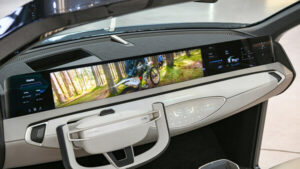
Hyundai Mobis working on panoramic infotainment, safety feature vehicle cockpit
By onTechnology
Hyundai Mobis has filed nine new patents to develop its future in-vehicle dashboard “moving panoramic screens.”
The system provides driving information, media content, and external communication. The patents are related to parts, mechanical package design, and user experience technology.
Tagged as a “digital cockpit,” the infotainment system is the company’s next-generation integrated driver’s system. M.VICS 5.0, under the development motto “All You Can See,” focuses on converging diverse display technologies, Hyundai Mobis said in a news release.
Since introducing M.VICS in 2021, annual upgrades have allowed the company to provide function features to analyze biometric signals such as posture, heart rate, and brain waves, the release states.
“From a design perspective, it seamlessly integrates the entire front panel from the left pillar of the driver’s seat to the right pillar of the passenger seat into a single, borderless, wide-screen cockpit. This includes a technology that adjusts the size and angle of the display panel according to driving modes.”
The M.VICS 5.0 display is made up of five display panels — a 27-inch main screen for dashboard and navigation information and media content; a 12.3-inch high-definition screen for the passenger, and a 7-inch screen for vehicle status information and button controls.
A projection display with touch and haptic feedback has also been added below the large screen.
Hyundai Mobis has designed each display panel to function independently according to its purpose and use environment while allowing integration into a single screen when needed, the release states.
The display panels can also be moved vertically and tilted. In “Drive Mode,” part of the panel lowers below the dashboard, transforming into a smaller display. “Theater Mode” is for watching media content and “Relax Mode” is for resting, allowing the steering wheel to lower, the seat and display to tilt, and the display’s size to adjust. Color scenarios aim to help reduce motion sickness.
The European New Car Assessment Program (Euro NCAP) will require more physical controls and fewer touchscreens come 2026 during its industry-respected safety tests; requiring OEMs to provide a button, stalk, or dial to control critical tasks such as direction indicators, hazard lights, aviation, honking a horn, window wipers, and SOS functions, according to a March Motortrend article.
Many U.S. studies and media reports in recent years have criticized the use of touchscreens in vehicles claiming they are distracting and dangerous. Yet, the use of touchscreens in vehicles has remained unregulated.
Porsche and Volkswagen have reportedly begun pulling back on putting touchscreen functions in their vehicles.
Hyundai Mobis says the large-screen display also has built-in safety functions. Lighting on both sides warns of potential rear-side collisions during boarding or getting out of the vehicle. Cameras mounted on the steering wheel and above the driver’s seat monitor real-time drowsiness and inattentive driving and issue emergency warnings.
Air bags are also located on the steering wheel, passenger roof, and at passengers’ knees.
Images
Featured image: Hyundai Mobis’ next-generation integrated driver’s system, M.VICS 5.0. (Provided by Hyundai Mobis)
